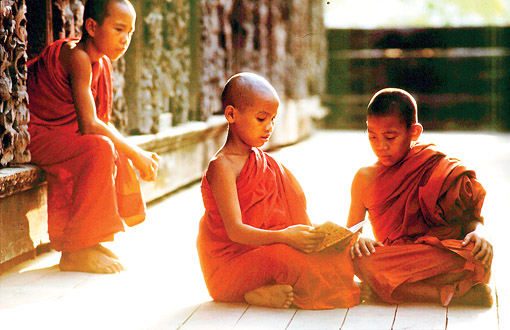
Why “Sakya” Nomenclature? The Power of Sakyan Identity
The British used “Depressed classes” as nomenclature for all Sakyans, the so-called untouchables in the pre-R.T.C. (Round Table Conference) period. But many members of the Sakyan community from all over India objected to the nomenclature of “Depressed Classes”.
It was considered to be degrading and contemptuous. Large numbers of telegrams have been sent by Sakyans from all over India supporting the demand of nomenclature. The following passage is part of Supplementary Memorandum on the claim of the Depressed Classes for Special Representation, submitted to the R.T.C. by Thatha Dr. R. Srinivasan and Babasaheb Dr. B.R. Ambedkar: “In dealing with this part of the question we would like to point out that the existing nomenclature of Depressed Classes is objected to by many members of the Depressed Classes who have given thought to it and also by outsiders who take interest in them. It is degrading and contemptuous, and advantage may be taken of this occasion for drafting the new constitution to alter for official purposes the existing nomenclature. ” Dr. Ambedkar, What Congress and Gandhi have done to the Untouchables (Nov. 4th, 1931)
Moreover, the memorandum suggested some nomenclatures i.e. “Non-Caste Hindus”, “Protestant Hindus”, or “Non-Conformist Hindus”, instead of “Depressed Classes”. But today many Sakyans may not agree with all these suggested nomenclatures due to a clear understanding of the distinction between Hindus and Sakyans.
Read also – What is there in a Name? There is a lot in the Name
After the R.T.C. the British Government used the nomenclature of “Scheduled Caste” for Sakyans. But Dalit Panthers in Maharashtra popularly used the word “Dalits”, which played a vital role in addressing Sakyans issues and oppressed position in the society.
Now many Sakyans think how long we call ourselves “Low Caste”, “Untouchables”, “Depressed”, “Suppressed”, and “Oppressed”. We need an identity or nomenclature with dignity and self-respect. We are the ancient race and original children of the soil. We have a great history, culture and tradition. We were peasants, rulers, saints, educated persons and business class in ancient India. From Buddha to Valluva, Valluva to Auvai, Auvai to Ravidas, Ravidas to Pandithamani Iyothi Thass, Iyothi Thass to Dr. Ambedkar, Dr. Ambedkar to Annai Meenambal, the Sakyans produced many great personalities.
To trace our glorious past, ancient history, ancient culture, ancient language, ancient religion, we need an identity/nomenclature. As soon as we say “WE ARE SAKYANS”, the other person should understand what we are and what is our history and culture.
Read also – Why I Use ‘Dalit’ Word
The claim of our Sakyan elders such as “Adi-Hindus”, “Adi-Dravidas” and “Adi-Tamil”, shows that we are ancient (pre-Dravidian, Pre-Tamil and Pre-Hindu) cultural or religious or ethnic group. Sakya identity is ancient to Tamil, Dravidian, Hindu identities. We have 5th century B.C. inscriptions, which carries the word “SAKYA”. If anyone brings any other inscriptions with any other words i.e. Tamils or Dravidians on the same period or before, we may accept that those were the nomenclature for ancient people in the Indian soil.
The Power of Sakyan Identity
Sakya is an identity of the so-called Untouchable communities. It implies their ancient historical glorious past, their ancient language, culture, literature and religion.
Shaktivel, IRS, one of our Sakyan brothers, has very well articulated the Sakyan identity of Sakiliyas, so-called untouchable community of the so-called Tamil Nadu. He also linked the community with other communities all over India i.e. Matangs of Maharashtra, Madigas of Andhra Pradesh and Chamars of North India.
There are two sociological terms, i.e. Sanskritisation and Palianisation. Sanskritisation is referred to the social mobility of a community, which tries to identify with higher Varna order and Palianisation is referred to the social mobility by claiming Sakyan or Buddhist root. Many so-called Untouchable communities or intellectuals from those communities claimed Shudra status. Many Shudra communities claimed Khsatriya status or Brahmin Status in Hindu hierarchy.
But Palianisation has not preferred the Brahmin status or Kshatriya status. Because the Sakyans were never part of the Hindu varna system. All Brahmanical Hindu texts and medieval Bhakti Hindu texts abused Sakyans as “outcaste” (Para Jati) or “outsiders” (Para Desi) or “out Varna” (Avarna). Claiming Sakyan identity is not the claim of higher varna in the Hindu varna system, rather it is to preserve the status of outsiders to Hindus or Varna system.
As Sakiliya’s identify themselves with Matigas of AP and Matangs of Maharashtra. The Pariahs also identify themselves with Malas of AP and Holayas of Karnataka and Mahars of Maharashtra. In the border districts of Tamil Nadu and Andhra Pradesh, Telugu speaking caste-Hindus call the Tamil-speaking Pariahs as “Tamil Malas”. In the border districts of Karnataka and Tamil Nadu, Tamil speaking caste Hindus call the Holayas as “Kannada-Pariahs”. In the border districts of Maharashtra and Karnataka, Kannada speaking caste-Hindus call the Mahars as “Marati-Holayas”.
The present-day Matangs (Chamars/Sakiliyas) and Mahars (Pallas/Pariahs/ Malas/Holayas) are not two different elements but two branches of same Sakyan Tree. This fact can be traced from the surname of a great leader, Dr. B. R. Ambedkar. He is an undisputable leader of all Sakyans, the so-called untouchable communities. Dr. B. R. Ambedkar’s original surname is “Sakpal”. “Sakpal” may be traced etymologically from Sakya Palla (Sakpal= Sakya+Pala (Palla)). A group of people from Mahar (Marati-Pariah) community, the ancestors of Dr. B. R Ambedkar and their descendants have been caring the surname
Sakpal, Sak (Sakya/Sakiliya) and Pal (Pala/Palla), to preserve the root of all Sakyan communities.
Sakpal means protector of Sakyans. Dr. B.R. Ambedkar proved himself he was the real protector of all Sakyan communities. Let all Sakyans enjoy the equal rights of Sakyan identity. Sakyan Identity is the real power to destroy the Brahmanical and non-Brahmanical Hindu hegemony and Hindu hierarchy. Let all Sakyans merge into a single identity for their own liberation and liberation of their oppressors.
Metta,
Sakya
May all beings be happy!
September 2004



+ There are no comments
Add yours